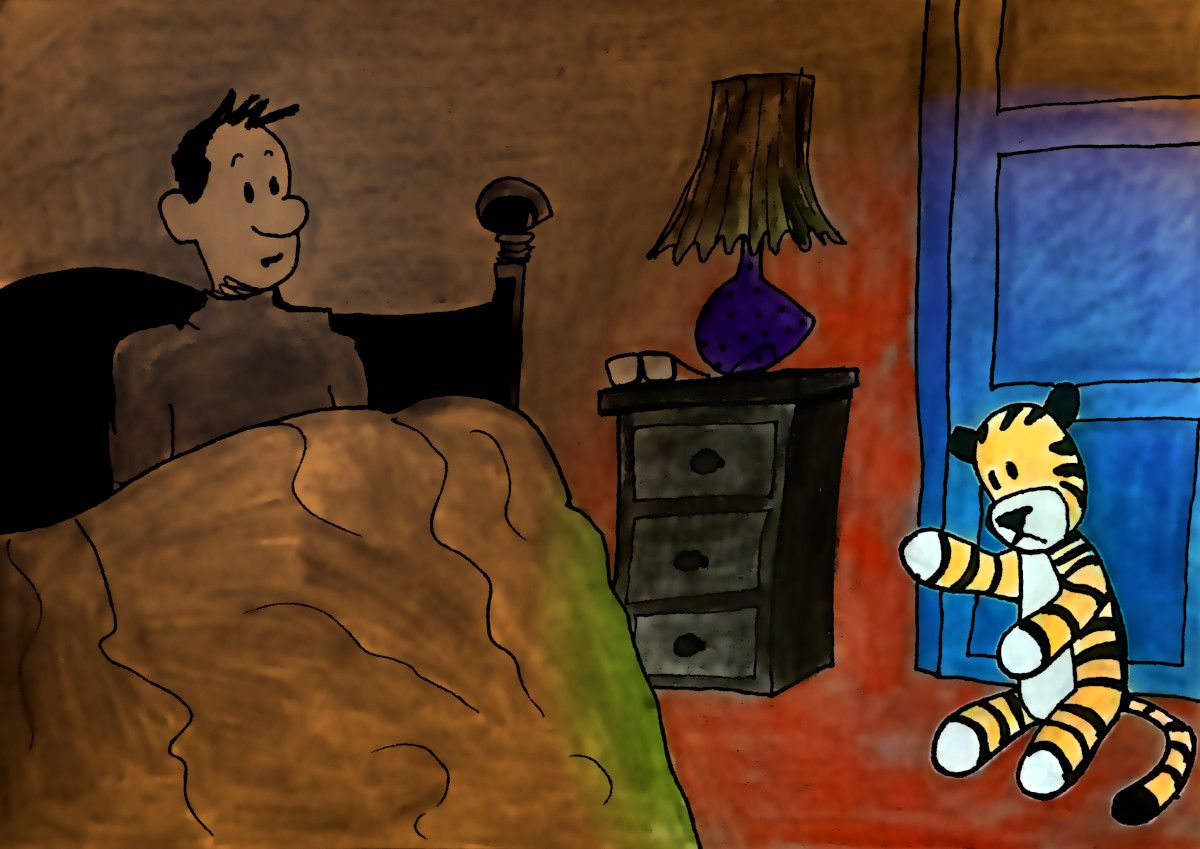Turning Colour
Our eyes can’t see anything before we’re born — but our brains can, through dreams.

Our eyes can’t see anything before we’re born — but our brains can, through dreams.
One can’t help but admire how Calvin’s dad from the Calvin & Hobbes comic strip is never at a loss for explanation. If he doesn’t know an answer, he simply makes it up. Of course, that comes with some weird situations, like when Calvin asks him why old photographs are in black and white.
“Those old photographs are in colour,” Calvin’s dad assures him. “It’s just that the world was black and white then. The world didn’t turn colour until sometime in the 1930s,” he explains, “And it was pretty grainy for a while too.”
“So then what about old coloured paintings?”
Calvin’s dad says that they were black and white to start with, but they turned colour in the ‘30s just like everything else. So did old photographs, but “...they were colour pictures of black and white, remember?”
This is a funny argument (just ask Calvin’s mother!), but it appears something like this may have been at play—not with photographs, but with dreams.
Maybe you’ve slipped from an edge that miraculously appeared. Perhaps you were pushed, or simply lost your balance. Or were you in a situation that you really disliked, and suddenly felt yourself losing physical control?
Whatever the beginning of the story may be, the feeling is much harder to forget: the feeling of falling. You’re falling at a fast pace, your heartbeat increases to an impossible rate; infact,it almost feels like it’s in your mouth, and you’re about to hit the ground…when you wake up with a jolt.
We’ve all had the falling dream at some point. It is a dream, simulated by the brain, but something about it feels so real, so raw, stirring up an emotion almost immediately, or even waking us up.
Dreams occur every time the brain goes through a REM cycle when we sleep, and often include the experiences we go through in our lives, jumbling them up completely, but making absolute sense to us until we’re awake once again. We usually don’t remember them unless we retell them almost immediately, as the brain discards these memories as a sort of “waste” product. (This often leads to the assumption that many of us don’t dream, or only dream occasionally!)
In the 1950s, it was assumed that everybody dreamt in black and white. It took another iconic Calvin to prove this wrong in 1951, when Calvin S. Hall announced in Scientific American that 29% of people’s dreams had colour in them. This percentage has increased over the years, in subsequent studies, until we’ve reached a point where everyone automatically assumes dreams are in colour.
Interestingly, the prevalence of colour in dreams is closely tied to the prevalence of colours in movies, which might have influenced people’s dreams.
Like most movie characters of her time, Dorothy Gale lives in an ordinary, sepia-tinted world in the 1939 film The Wizard of Oz. But when her house gets carried away in a tornado, she steps out to find herself in a colourful world of technicolour!
The Wizard of Oz was one of the world’s first colour movies, and it was a big hit in its time. Technicolour was a new technology, which even led Calvin Hall to describe the coloured dreams people were seeing at the time as “technicoloured”. In 1962, a Swedish April Fool’s hoax saw people draping nylon stockings on their black-and-white TVs, because they were told it would make them coloured. Soon afterwards, though, colour TVs became pretty common, at least for primetime broadcasts…and coloured dreams became more common too.
A 1962 survey saw 83% of people reporting coloured dreams when they were shaken awake and questioned in the middle of the night. A 1968 study reported the number as 62%, but in 1970, when Americans had started buying more colour TVs than black-and-white ones, scientist F. Snyder suggested that perhaps all dreams are in full-colour. The trend continued, and nowadays it is generally assumed that peoples’ dreams are coloured.
Why this curious connection between movie technology and dreams? Could it be that black and white movies had made people dream black and white too, and that effect is now reversed?
One study in 2002 tried surveying people’s dreams, including people and surveying techniques from both these generations, and did indeed find a correlation.
At the very least, we can say this theory isn’t as unlikely as that of Calvin’s father!
While the link between dream colours and movie-watching habits are tenuous to say the least, there is a related, and equally intriguing question. Forget the colour of the movies you watch: what happens to the dreams of people who’ve never seen colour in their lives?
Colour blindness comes in many forms. At its most serious, a rapid side-to-side- eye movement called “nystagmus” accompanies the inability to see colour; at its least, you may not even realise you have it. Since nobody is aware of how colour is perceived by other people, everyone assumes what they see is normal — in fact, it is normal for them.
If what you see is normal, it follows that your dreams are normal too. People suffering from a specific type of colour blindness — say red-green colourblindness — dream in the same colour palette they see while awake. If they were born unable to see colour, they would dream in black and white, because their brains have no references of coloured images to draw from.
Even though in most cases, this condition arises at birth itself through genetics, it can unfortunately also set in later in life if a disease or injury impacts certains parts of the eye or brain.
These people are unable to see some colours in reality from this point on, but interestingly the brain still holds the memory of these colours. Therefore, their dreams often feature colours from their earlier days which they are no longer able to directly see in reality.
Before you are born and open your eyes to the world, you still have visual experience — as an infant, in your dreams.
Vision is a complicated topic, but here’s the brief version: light hits your retina, which triggers electrical signals going through the optic nerve to your brain — at which point it’s all put together to compute the image you see in your head. That means visual impairment can happen in multiple ways. If your eyes and optic nerves are messed up, then your brain technically still has the ability to experience visual sensations — it’s just that the information is garbled.
This is what happens to people who are not yet born, as well as those who are blind from birth. According to brain scans, they experience the same type of vision-related electrical activity in their brain as people with perfectly normal eyesight, and even move their eyes as if trying to see. Their brains, it seems, are experiencing visual sensations — they just struggle to connect these sensations clearly or describe them in ways people with normal eyesight can.
Being visually impaired means dreaming more often in sounds, smells, and touch. What images come through are from electrical fluctuations in the brain, rather than light from the eyes, so they could often be more like splotches of colour correlating with other senses. Slow moving dots of colour could accompany a dream of listening to classical music at a dance, or tasting or smelling some foods could be correlated with other colours.
Those who become blind during the course of their lives tend to dream more visually. There is in fact a direct correlation between visual dreams and the age at which one becomes blind: the longer you’ve had vision, the more often you continue to see things even in dreams.
In an attempt to beat internet addiction, the Greyscale Challenge asks people to put people to put their phones into black-and-white mode. This is the theory of Calvin’s dad operating in reverse, as colour photos on devices are displayed through black and white screens.
With a new normal of seeing things in black and white again, who knows, we might finally find more proof to the theory connecting black and white dreams to the films we see. Or perhaps we’ll get bored of the novelty and let our digital reality turn colour again.
Just like everything else did, in the ‘30s.
